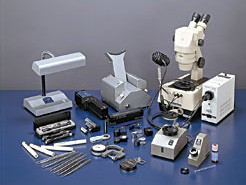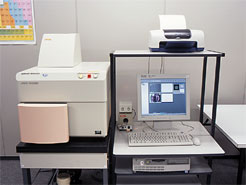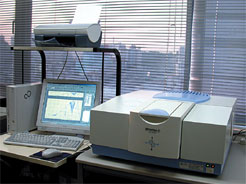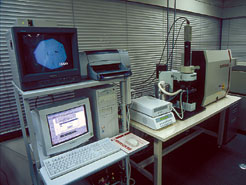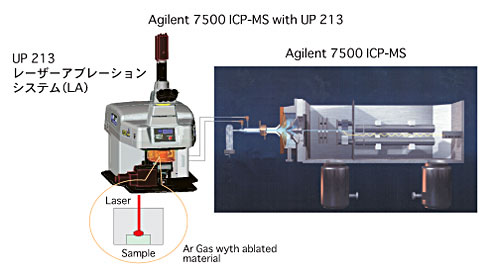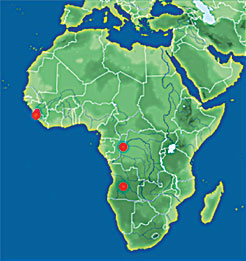|
|||||||||||||||||||||||||||||||||||||||||||||||||||||||||||||||||||||||||||||||||||||||||||
| A meeting of the Gemmological Society (Japan) in 2004 was held on Saturday 12th June at Kyoto City International Foundation, and authors addressed a lecture on “Application of LA-ICP-MS (Laser Ablation Inductively Coupled Plasma Mass Spectrometry) to Gemmological Field”. The contents are introduced here. 1. Introduction Gemmological laboratories in recent years have diverse issues that are difficult to solve and many gemmologists have been thrown into confusion. The major propositions are: 1. Geographical origin determination of a gemstone, 2. Detection of diversified treatment techniques, 3. Sophisticated analyses. Geographical origin determination of a gemstone does not indicate quality or value of the gemstone and should be regarded as an opinion proposed by the gemmological laboratory that identifies its locality. CIBJO regulations also have this philosophy as its basic principle. However, origin determination of gemstones of the same mineral variety and from similar occurrence is the most difficult task, and if different laboratories make different origin determination on a single stone, customers will be confused and eventually laboratories will lose their trust. Therefore, origin determination should be made on more sophisticated scientific basis. Heat treatment processes aiming at colour improvement or alteration of a gemstone have developed from the traditional methods such as using Geuda, and heating processes from low to high temperature with diversified environments (oxidising-reducing atmosphere, controlling various gas induction) or artificial diffusion heating process using external additives are among newly developed methods. By general identification methods, these complicated heating processes are quite difficult to detect. Gemstones are rocks and minerals, and their compositional analysis is inevitable to gemstone identification. X-ray fluorescence analysis (XRF) is generally used for elemental analysis at the gemmological laboratories. The XRF analysis has excellent operational ability and it can analyse main elements and trace elements simultaneously, however, there are some problems in analysis of light elements and detection limit, and more sensitive elemental analysis is required (Fig.1).
To solve various problems in gemstone identification mentioned above, several laboratory techniques such as spectral analysis using different wavelength of light (UV-Vis-IR) and Raman spectral analysis are used. However, these analytical methods also pose limitations and the problems may not be solved. So our research laboratory focused attention on a laser ablation analysis (LA-ICP-MS method) which can perform local analysis on a solid sample with keeping high sensitivity of ICP-MS, and have started applying the method to analysis of chemical composition and trace to ultra-trace elements in gem minerals, in order to solve the various problems. The study results authors have obtained so far (partially including study results of other researchers) are introduced here. 2. Analysis Methods In LA-ICP-MS analysis, NEW WAVE RESEARCH, MODEL UP-213A/F and AGILENT, 7500A are used for a laser ablation system and ICP-MS respectively (Fig.2).
3. Geographical origin determination Origin determination indicates geographical area and geological occurrence of a gem mineral but never indicates commercial value. However, the knowledge of accurate locality will help supply of more detailed information on a gemstone. By analysing ultra-trace impurity elements contained in a gemstone, authors studied geographical origin determination of diamond, sapphire and emerald. ● Diamond In the 1990s, most of the diamonds illegally flowed from Sierra Leone, Angola and Congo were sent to Antwerp in Belgium or Tel Aviv in Israel, where were the centre of diamond trading (Fig.3). The benefit from diamond trading out of control is used to buy weapons or for armed struggle. International conferences aiming at cleaning up such “conflict” diamonds were held recently and establishment of international certification system for diamond was proposed as the objective, but it does not go far enough to solve the problem fundamentally. Gemmological research institutions or laboratories in the world are facing new demand of identification of these “conflict” diamonds, i.e., origin determination of diamond. Diamond is formed mainly in the upper mantle, 100 to 400km under the ground. This is a crystal made of carbon with very few impurities, so that it is less diverse than other minerals with complicated chemical composition such as ruby, sapphire and emerald. Because of this, it is not practical to identify the origin with the accuracy of trace element analysis by traditional methods such as X-ray fluorescence analysis. LA-ICP-MS method, which can make highly sensitive analysis, is then expected to be applied to origin determination of diamond. According to “Rapaport Diamond Report, September, 2003”, after analysing a rough diamond from Congo, which has transparent centre and pale gray-green surface colour, by LA-ICP-MS method, ultra-trace elements such as Sr, Zn, Ba, La or Ce in several to several dozens of ppm order were detected (Table-1). In “M. Resano et al., 2003”, diamonds from Premier mine in South Africa, Prapa mine in Botswana, Udachnaya in Russia and Panda mine in Canada were analysed and characteristic features of each locality with the guideline of nine trace elements, Al, Hg, Na, Ni, Pb, Sb, Sn, Ti and Zn, were introduced.
● Corundum Geological occurrences or optical, spectral and chemical compositional features and properties of ruby and sapphire from all over the world have been introduced in many literatures in years. However, locality identification of rubies or sapphires from the same origin of formation and the same occurrences by internal features or spectral analyses is difficult and a laboratory may present different result from other laboratory. Authors studied on locality identification of blue sapphire by LA-ICP-MS method. With traditional tests (such as observation of internal features, spectral analysis and analysis of trace elements by X-ray fluorescence), distinction between stones of basaltic origin (from Thailand, Australia and China) and non-basaltic origin (from Sri Lanka, Myanmar and Madagascar) is possible but locality distinction between stones within the same origin is quite difficult. Our trace analysis by LA-ICP-MS method was made on Cr2O3%/Ga2O3% and Fe2O3%/TiO2%. Sapphires of basaltic and non-basaltic-related origin can be clearly separated by “Chemical Finger Print”, and non-basaltic origin stones from Sri Lanka, Myanmar and Madagascar can be separated from each other by combination of the “Chemical Finger Print” and contents of ultra-trace elements such as Zn, Sn, Ba, Ta and Pb (Fig.4) (Ahmadjan A. and H. Kitawaki, 2004).
Emerald, which is the most valuable variety of beryl group, is crystallised under very complicated geological environments, and the crystal reflects abrupt changes of geological environment or mechanical stress. Contrary to this, other beryl minerals such as aquamarine develop in relatively calm environments. Emerald mines are distributed over the five major continents on the earth, and famous localities are Columbia and Brazil in the South America, Ural Mountains, Pakistan and Afghanistan in Asia, Egypt, Zambia, Zimbabwe and Madagascar in Africa. The authors have been working on fingerprints of pegmatite-related emeralds from Kaduna in Nigeria, Zambia, Zimbabwe, Carnaiba-Sokoto in Brazil and emeralds not related to pegmatite from Oriental, Goias and Bahia in Brazil and Swat in Pakistan, by trace elements such as Cr, V, Fe, Mg, Na, Ga, Mn, Co, Rb, Sr, Sn, Ce, Hg, Tl and Pb. |
|||||||||||||||||||||||||||||||||||||||||||||||||||||||||||||||||||||||||||||||||||||||||||
|
|||||||||||||||||||||||||||||||||||||||||||||||||||||||||||||||||||||||||||||||||||||||||||
